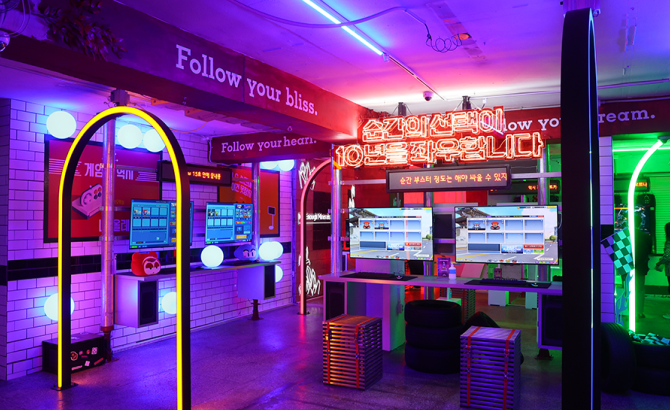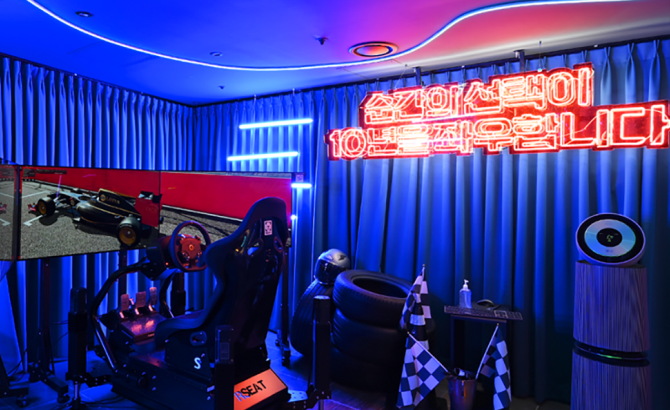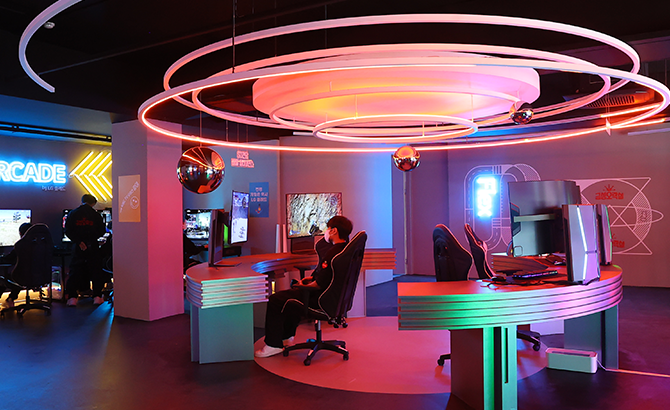
The Goldstar Arcade project originated from the challenge of establishing a familiar relationship between LG OLED TVs and the MZ generation, ultimately aiming to build brand fandom. At that time, LG OLED TVs held a dominant 70% market share in the global OLED TV market, achieving record shipments and high brand awareness. However, the awareness among the emerging MZ generation, a key future consumer demographic, was relatively weak.
Based on internal surveys, it was found that while the MZ generation was generally aware of LG OLED TVs through TV advertisements, they expressed reluctance to visit stores like Best Shops to experience the products firsthand. There was a lack of touchpoints that could provide an appealing experience for the MZ generation. Therefore, the goal was to create an LG OLED TV customer experience space that would be attractive to the MZ generation.

With the retro trend sweeping through areas like Euljiro, Seongsu-dong, and Ikseon-dong, where the past and present coexist, there was a shift in the mobile population of the younger demographic. Additionally, retro-themed content stimulating nostalgic emotions gained popularity in broadcasts, and brands began deploying various marketing campaigns with a retro concept, such as Jinro soju and Gompyo beer. This retro trend was perceived as a new trend for the 10-20 age group and as a sentiment that evoked nostalgia for the 30-40 age group. Recognizing this, it became evident that retro was a crucial point for targeting the MZ generation that LG OLED TV aimed to capture.
To establish a connection between LG OLED TV and the MZ generation, common ground that could link them was considered. The key selling point of LG OLED TV, "gaming," was identified as an attractive and engaging content for the MZ generation.
Building on these insights, the retro-themed "Goldstar" brand code owned by LG and the gaming content, a major selling point of LG OLED TV, were utilized to create a customer experience space with the concept of an "Arcade. "

1 Experience focused on positive emotions felt while watching TV
The focus was not just on what the space would be but on creating experiences within the space. Following the idea of "Sell the sizzle, not the steak," the goal was to showcase the value of positive experiences rather than directly conveying product information. The experiences were designed around positive emotions felt while watching TV, such as the sense of time flying and the enjoyment factor.
2 Selection of meaningful and popular gathering places and spaces for the MZ generation
The crucial aspect was selecting the location and space. "Seongsu-dong" was chosen as the area, known for its retro vibe and popularity among the MZ target demographic, characterized by frequent gatherings and a high influx of people. Specifically, spaces were chosen that could establish a unique identity for Goldstar Arcade rather than generic shared spaces, ensuring it stands out. This criterion continued in subsequent seasons with the selection of spaces like Busan Gwangalli Beach Theme Street and a standalone building in Gangnam.
3 Selection of retro games as the main content for the MZ generation
For the main content of the arcade, games were chosen that the MZ generation would perceive as retro, rather than classic or modern games. Emphasis was placed on games continually remastered to vividly showcase the quality of LG OLED TV.
4 Configuration of a space with diverse content enjoyable for the MZ generation
The space wasn't limited to gaming but included various content enjoyable for the MZ generation. Collaborations with different brands showcased Goldstar goods, and a collaboration with Shinsegae Food resulted in a space where affordable nostalgic snacks could be enjoyed. In Season 2, collaborations with brands like Tor Container, Ballantyne, and Map Date provided a space to enjoy trendy goods and food items, reflecting the local characteristics of Busan.


The response was overwhelmingly positive, surpassing the expected number of visitors and leading to long lines outside Goldstar Arcade. The digital realm generated over 880,000 social actions, with Goldstar Arcade content prominently displayed on social media. Positive reactions spread not only to the Goldstar Arcade space but also to the LG OLED TV brand. Influencers, media, and the general public voluntarily shared positive content, turning Goldstar Arcade into a trending and hip space.
This success resulted in continuous inquiries for collaborations from various media and brands, solidifying Goldstar Arcade as an exemplary case in customer experience spaces and experiential marketing. With each season, from Seongsu in Season 1 to Gwangalli Beach in Season 2 and Gangnam in Season 3, Goldstar Arcade continues to expand and upgrade, attracting increasing attention!

Production

Season 1 : Seoul Seongsu

Season 2 : Busan Gwangalli
